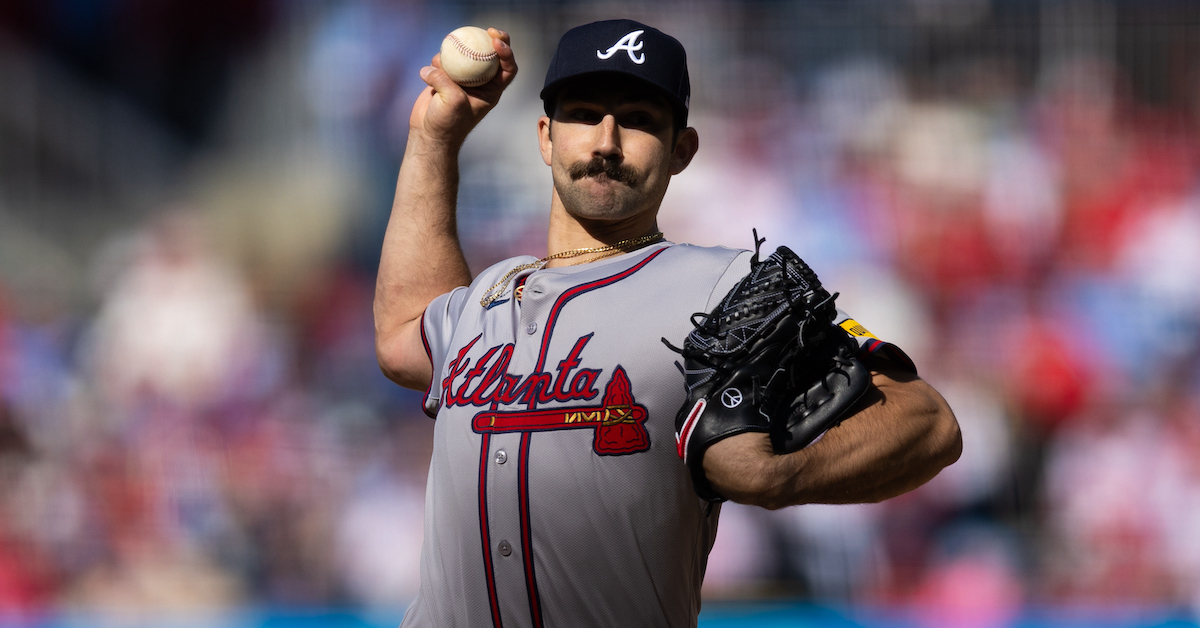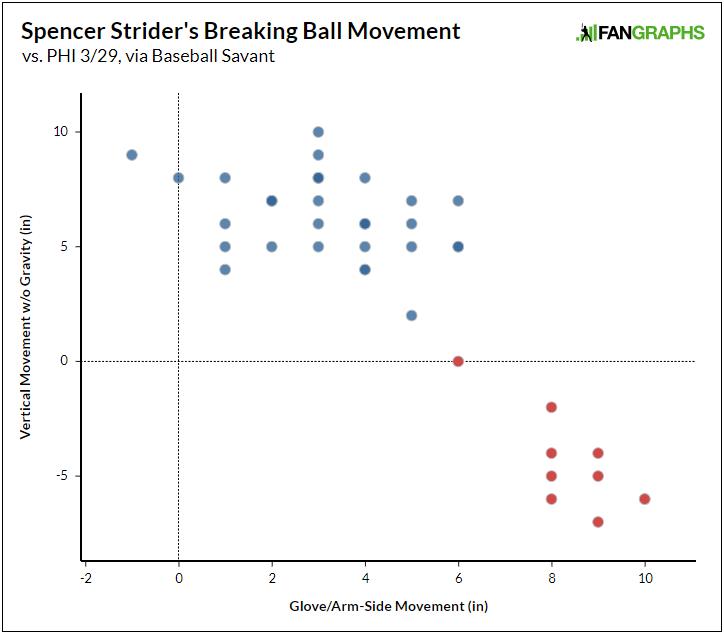
Bill Streicher-USA TODAY Sports
For my money, the best pitcher in the National League right now is Braves right-hander Spencer Strider. The 25-year-old with the Kurt Russell-in-Tombstone mustache struck out 281 batters last year, which is impressive in any context, all the more so because he did it in just 186 2/3 innings, while using two and a half pitches. He’s got an upper-90s four-seamer, an outrageous slider, and a changeup that he uses sparingly against lefties and basically not at all against righties.
Strider’s slider (which is a top-three Shel Silverstein poem) is clearly capable of serving as a secondary arsenal all on its own. That’s because Strider can add or subtract from the pitch at will. Last year, he threw more than 1,000 sliders in the regular season, and those pitches varied in velocity by 10 mph, in spin rate by more than 500 rpm, in gravity-adjusted vertical movement by 16 inches, and in horizontal movement by 10 inches. In short, it’s technically one pitch, but with a lot of room to change speed and shape.
Nevertheless, Strider has added a curveball this season, and after a soft launch in spring training, he threw it in anger for the first time on Friday.
The Opening Day matchup in Philadelphia between Strider and Zack Wheeler might be the best starting pitching matchup we see all season, and for six innings it lived up to its billing. Wheeler threw six scoreless innings, striking out five and allowing as many hits — four singles and a double. Strider buzzed through four innings before he got into a little bit of trouble in the fifth as his velocity started to drop.
The only blemish on his performance was a two-run home run by Brandon Marsh — hit at 103.9 mph, to the opposite field, into a pretty hellacious wind. It wasn’t on a breaking ball, rather a pedestrian (by Strider’s standards) 95.6 mph fastball left middle-middle. Any pitcher who throws that pitch in that spot — even Strider — is probably going to get taken deep.
Strider ended his afternoon with eight strikeouts in his bag, and while he left the game down 2-0, the Phillies’ bullpen barfed up the lead like a baby that’s eaten too much squash puree. Atlanta scored seven runs in the top of the eighth and went home with the win.
In his 90-pitch season debut, Strider found occasion to sprinkle 10 curveballs in among 32 sliders. He said after the game that the curveball is now fully integrated into his repertoire, and that he expects it to be a spectacular swing-and-miss pitch.
“I’m past the point of being surprised by it,” he said. “So now I’m at the point where, when it doesn’t work, I get mad. That tells you how comfortable I am.”
Strider did allow one hit off his curveball; it was the one curve he left out over the plate, and Bryson Stott grounded it back up the middle for a single. The other nine pitches went to the glove side, seven of them low and out of the zone. Those pitches generated two swinging strikeouts, and he managed to sneak two other curveballs into the zone for called strikes. Strider could afford to use the curveball as a chase pitch because he threw them almost exclusively while ahead in the count — one first pitch, two 2-2, the other seven either 1-2 or 0-2.
That’s a more extreme version of his breaking ball tendencies overall. Out of those 42 total breaking balls, only eight came while Strider was behind in the count. Twenty-seven of 42 breaking balls were thrown out of the strike zone, and 34 out of 42 went to Strider’s glove side.
Strider isn’t trying to reinvent the wheel with his new breaking ball. He’s just adding another wrinkle.
“It’s not too dissimilar to the thought process of the slider, it’s just a different shape,” he said. “So it kind of works the same way. Instead of having to use the slider in 100% of the situations where I would use a breaking ball, I don’t have to pull the slider into certain contexts in which it might not be the best option.”
It does invite the question of why he’d bother adding a new breaking pitch when the slider already works in that low-80s velocity band. But while he can drag the slider down into his curveball’s velo range, this is clearly a distinct pitch. Here’s the velocity and the spin rate of the two pitches from Friday’s start, with curveballs marked in red.

There’s a subtle difference between the curveball and slider in terms of how it comes out of Strider’s hand. The curveball breaks harder early in the flight path compared to the slider, even when the ultimate velocity of the pitch is similar. In the video clips linked in the previous sentence, it’s a bit harder to pick up the horizontal movement on Strider’s breaking balls from the game on Friday because the center field camera angle at Citizens Bank Park is off-center. But here’s a helpful chart, again with sliders in blue and curveballs in red.

Early returns look pretty solid for Strider, but we’ll only know how the curveball plays after the league gets a couple looks at it and has a chance to adjust. My big question is about velocity. Strider’s curveball averaged 80.6 mph on Friday, and his fastball averaged 96.7 mph. That’s already an enormous velocity gap; last season, only six starting pitchers who threw at least 10% curveballs and 40% four-seamers had a velo gap that big. And Strider usually throws his fastball another mile an hour or two harder than he did on Friday.
On one hand, the ability to pull the string on hitters like that is pretty enticing. I don’t know about you, but I played a lot of MVP Baseball 2005 on GameCube and had an absolute nightmare trying to hit Jason Isringhausen’s 94 mph fastball and 66 mph knuckle-curve. My biggest concern is that a professional hitter ought to be able to read that velocity differential early enough to know to lay off. And a lot of the hard-throwing pitchers with a slow curve (Wheeler, Gerrit Cole, Logan Gilbert) have goofy kitchen sink arsenals with five or six pitches and multiple fastballs.
Strider is still fundamentally a fastball-slider pitcher who’s putting a backup gun in an ankle holster. So can it be done?
I have three reasons to be optimistic; two of them are a little fuzzy, while the other one’s grounded in historical fact. First: Strider is a very skilled, intelligent pitcher, and he deserves the benefit of the doubt if he thinks his new pitch is going to work. Second: The velocity gap gets less scary when you think of the curveball as a pitch to be thrown off the slider, rather than off the fastball. He said it himself — the curveball is for breaking ball situations where the slider might not be the ideal tool for the job.
And third: Imagine a pitcher with a hard four-seamer, a biting mid-80s slider, a slow curve, and an in-case-of-emergency changeup to be used against tough lefties. Is Strider really breaking new ground, or did he just invent a shorter version of Justin Verlander?
Source
https://blogs.fangraphs.com/spencer-strider-has-a-new-toy-lets-see-how-it-works/
 Backyard GrillingWeekend WarriorsAdvice from DadBeard GroomingTV Shows for Guys4x4 Off-Road CarsMens FashionSports NewsAncient Archeology World NewsPrivacy PolicyTerms And Conditions
Backyard GrillingWeekend WarriorsAdvice from DadBeard GroomingTV Shows for Guys4x4 Off-Road CarsMens FashionSports NewsAncient Archeology World NewsPrivacy PolicyTerms And Conditions
